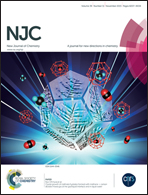Colloidal synthesis of MoS2 quantum dots: size-dependent tunable photoluminescence and bioimaging†
Abstract
Although the synthesis of two-dimensional (2D) layered MoS2 nanomaterials has been developing rapidly, there are many technical issues in preparing MoS2 quantum dots (QDs) with photoluminescence properties. Herein, we design a facile colloidal chemical route to prepare photoluminescent MoS2 QDs using ammonium tetrathiomolybdate ((NH4)2MoS4) as a precursor and oleyl amine as a reducing agent. The optical properties and structure of as-prepared MoS2 QDs are investigated systematically. The resultant MoS2 QDs exhibit fluorescence (λmax = 575 nm; quantum yield, 4.4%), spherical morphology with a uniform thickness of ∼3 nm and an excitation-dependent PL phenomenon. Moreover, the resultant MoS2 QDs show size-dependent tunable photoluminescence in the wide visible region. With the help of amphiphilic compounds, the resultant MoS2 QDs could be transferred from an organic to an aqueous phase. MoS2 QDs in aqueous solution have many advantages, such as good dispersion, low toxicity and photoluminescent properties, which make them promising materials for application in optoelectronic and biological fields. In this study, the 293T cells are used as a model to evaluate the fluorescence imaging of MoS2 QDs. The results confirm that the fluorescent signal appears in the cytoplasm which demonstrates that as-prepared MoS2 QDs could be used as a probe for real-time optical cellular imaging.


 Please wait while we load your content...
Please wait while we load your content...